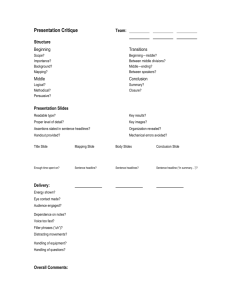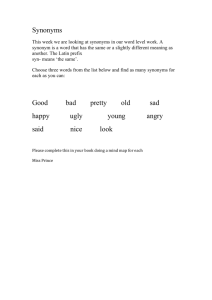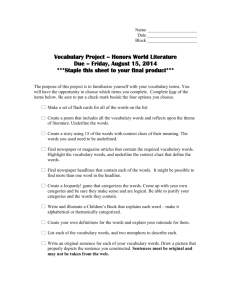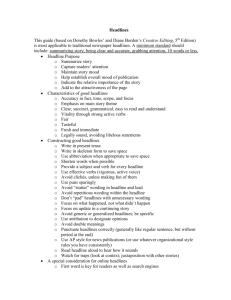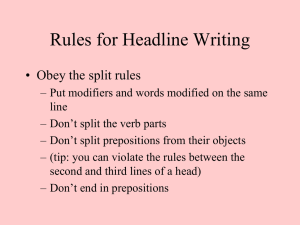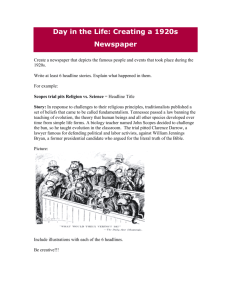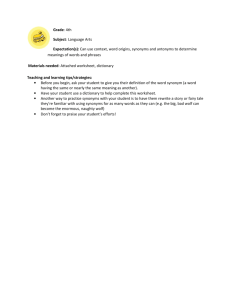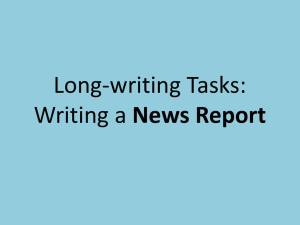Lesson 9 - Ellsworth American
advertisement
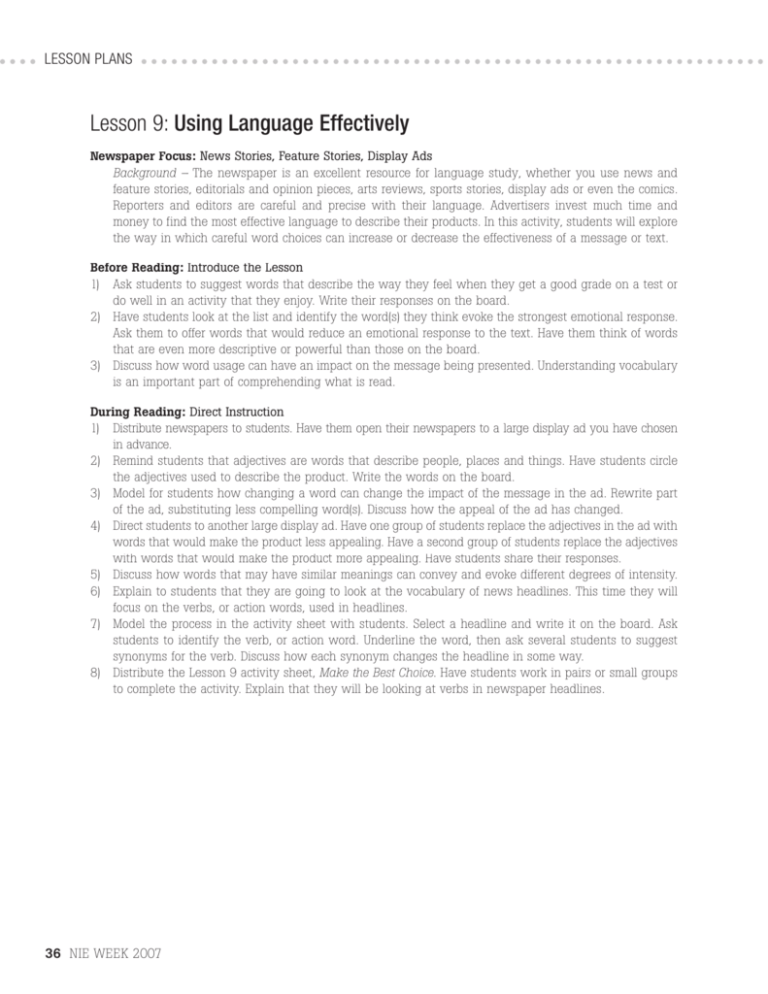
LESSON PLANS Lesson 9: Using Language Effectively Newspaper Focus: News Stories, Feature Stories, Display Ads Background – The newspaper is an excellent resource for language study, whether you use news and feature stories, editorials and opinion pieces, arts reviews, sports stories, display ads or even the comics. Reporters and editors are careful and precise with their language. Advertisers invest much time and money to find the most effective language to describe their products. In this activity, students will explore the way in which careful word choices can increase or decrease the effectiveness of a message or text. Before Reading: Introduce the Lesson 1) Ask students to suggest words that describe the way they feel when they get a good grade on a test or do well in an activity that they enjoy. Write their responses on the board. 2) Have students look at the list and identify the word(s) they think evoke the strongest emotional response. Ask them to offer words that would reduce an emotional response to the text. Have them think of words that are even more descriptive or powerful than those on the board. 3) Discuss how word usage can have an impact on the message being presented. Understanding vocabulary is an important part of comprehending what is read. During Reading: Direct Instruction 1) Distribute newspapers to students. Have them open their newspapers to a large display ad you have chosen in advance. 2) Remind students that adjectives are words that describe people, places and things. Have students circle the adjectives used to describe the product. Write the words on the board. 3) Model for students how changing a word can change the impact of the message in the ad. Rewrite part of the ad, substituting less compelling word(s). Discuss how the appeal of the ad has changed. 4) Direct students to another large display ad. Have one group of students replace the adjectives in the ad with words that would make the product less appealing. Have a second group of students replace the adjectives with words that would make the product more appealing. Have students share their responses. 5) Discuss how words that may have similar meanings can convey and evoke different degrees of intensity. 6) Explain to students that they are going to look at the vocabulary of news headlines. This time they will focus on the verbs, or action words, used in headlines. 7) Model the process in the activity sheet with students. Select a headline and write it on the board. Ask students to identify the verb, or action word. Underline the word, then ask several students to suggest synonyms for the verb. Discuss how each synonym changes the headline in some way. 8) Distribute the Lesson 9 activity sheet, Make the Best Choice. Have students work in pairs or small groups to complete the activity. Explain that they will be looking at verbs in newspaper headlines. 36 NIE WEEK 2007 LESSON PLANS After Reading: Reflect and Review 1) Have students share their responses. Guide the discussion to help students recognize the changes in meaning that occur when they use different vocabulary words or synonyms. 2) Ask students to identify the headline they liked most. Have them discuss how the verbs used in the headline attracted and appealed to them. Performance Rubric Expectation: The student was able to … Exceeds expectations Meets expectations Revisit Identify verbs in headlines (see query above) Generate a variety of appropriate synonyms Compare and contrast the differences in meaning between various synonyms NIE WEEK 2007 37 LESSON PLANS Student Activity Sheet 9: Make the Best Choice You can learn about the power of how words are used by studying the choices made in newspaper headlines. ☞ Words are called “synonyms” when they mean about the same thing. But synonyms never mean exactly ☞ ☞ ☞ the same thing. There is always a slight difference in meaning. For example, the verbs “rushed” and “hurried” both mean that someone or something was moving fast. The word “rushed,” however, suggests a faster speed than “hurried.” Pick five headlines from anywhere in your newspaper. Write each headline in the chart below. Underline the verb, or action word, in the headline. Write the definition of the verb in the second column. Think of three words that could be used as synonyms for the verb from the headline and write them in the third column. Headline Definition of verb (action word) Synonyms for the verb 1. 2. 3. 4. 5. Rewrite one of the headlines and replace the verb with one of the synonyms you wrote in the third column. _____________________________________________________________________________________________ Describe how the synonym changes the impact of or response to the headline. _____________________________________________________________________________________________ Discuss why you chose a particular synonym. Describe how you think the headline is different because of the change you made. _____________________________________________________________________________________________ 38 NIE WEEK 2007
